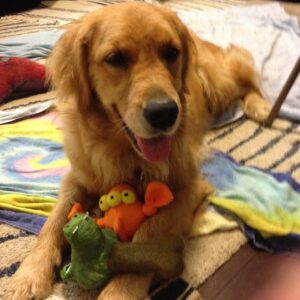Barks Blog
Wanna Play?

Humans and dogs love to play together; from recent research, it seems that this shared love for play has been a key element in shaping our close bond. While there is still a question as to whether shared play creates a solid relationship between a person and a dog or it merely adds to an already strong bond, what’s certain is that people who play frequently and intensively with their dogs enjoy those relationships more — as do the dogs.
A recent paper by John Bradshaw, “Who do adult dogs ‘play’?” considers possible explanations for the playfulness of our canine pals. One aspect of play, also studied by ethologist Marc Bekoff, is how play affects relationships between conspecifics — particularly those of different ages and/or sizes as well as play between humans and dogs.
Bekoff has argued that playful interactions among littermates form the basis of puppies’ system of ethics. As in the puppy version of the golden rule: if you hurt me, I won’t play with you, and I will yelp loudly enough to ensure that none of the other puppies will play with you, either.Young puppies start to learn bite inhibition while playing with their siblings. They also learn that if they solicit play and then behave in a non-playful way — biting too hard, for examples — the other puppies will ostracize them.
Bekoff cites four“rules” of canine play: communicate clearly; mind your manners; admit when you are wrong; and be honest. In other words, don’t lie, don’t hurt others, and take responsibility for your actions and their consequences. Makes sense to me, but the idea of doggy ethics is still hard for many researchers and dog professionals to swallow.
What we can (nearly) all agree on, though, is that adult dogs and large dogs self-handicap when playing with smaller dogs or with puppies. This shows awareness of their greater strength as well as willingness to “lose” a game in order to prolong a play session or encourage the smaller / younger dog to play. A puppy who is constantly manhandled (dogpawed?) by a larger playmate is unlikely to keep coming back for more. Play is, apparently, enjoyable, for dogs of all ages and sizes, so the larger dog wants to keep it going more than he or she wants to be “top dog.”
Bekoff also states that, when accidents happen — a dog bites too hard or body-bumps another too roughly — that dog “apologizes” by play bowing or using other body language and signals that he or she wishes to continue playing. Dogs usually accept these apologies, and play continues.
A similar element of play between unmatched dogs, which Bradshaw calls role reversal, occurs when the larger or more powerful dog engages in behaviors that are typical of smaller or weaker dogs — these could include behaviors we tend to regard as submissive in dogs, such as lowering the body to the ground or offering the belly. My 60-lb., 2-year-old golden, adores small dogs; at play group, she comically flattens herself on the ground and sometimes even rolls over in her attempts to appear smaller to the tiny toy poodle she’s inviting to play.
Bradshaw points out that these behaviors are “non-adaptive,” which basically means that there is no clear benefit to the dog and even a possible “cost,” in terms of lost status. Why, then, would dogs do this?
We can also ask this question about some play between humans and canines, where one or often, both self-handicap. Dogs certainly exercise considerable bite inhibition when wrestling or playing tug-o-war with humans. And most dogs seem to instinctively know to ratchet their play down several levels when playing with a small child or otherwise frail person. Humans, too, self-handicap by “letting” the dog win at tug-o-war or holding back from using our full strength and weight in a wrestling match. If we always won, play would lose its appeal for the dog (and likely for us as well).
 Play clearly appeals to both dogs and humans, for reasons that go beyond any possible utility. Explanations that tie some play behaviors to adult skills, such as hunting, don’t really apply to dogs and humans wrestling, playing tug-o-war, or playing fetch. A persistent myth claims that much canine play is about status-seeking (this myth often comes with dire warnings against ever letting your dog win a tug-o-war game). Bradshaw cites studies that have found no evidence whatsoever that play with humans increases competitive or aggressive behaviors in dogs.
Play clearly appeals to both dogs and humans, for reasons that go beyond any possible utility. Explanations that tie some play behaviors to adult skills, such as hunting, don’t really apply to dogs and humans wrestling, playing tug-o-war, or playing fetch. A persistent myth claims that much canine play is about status-seeking (this myth often comes with dire warnings against ever letting your dog win a tug-o-war game). Bradshaw cites studies that have found no evidence whatsoever that play with humans increases competitive or aggressive behaviors in dogs.
What does seem to be evident, backed up by several studies, is that play is an indication of positive relationships — both between dogs and between a dog and a human. Dogs see playful, positive contact with familiar humans as a powerful reward, which many canny trainers put to good use in their work with dogs.
In what might be a bit of a chicken-and-egg argument, Bradshaw suggests that, because play only takes place when conditions are good — both parties are relaxed and, generally, have their basic needs met — play indicates a good relationship. He also states that more frequent and/or more intense play correlates with higher levels of obedience, possibly because play was used as a training reward in these dog-human pairs. Play is less interactive between dogs and owners who use physical punishment in training. Therefore, using play-as-reward could contribute to building a stronger relationship.
So, play might both lead to and result from a stronger relationship between a human and a dog.
As to why adult dogs play — and play far more than adults of wild canine species — Bradshaw echoes other researchers in suggesting that humans might have selected for playfulness in breeding or choosing our canine buddies. We might also, intentionally or not, have selected for it in breeding for other traits, from the truncated prey sequences in retrievers and herding dogs to our selection of juvenile characteristics (floppy ears and other puppyish traits). We simply like playful dogs, and we find dogs more useful when their behavior is less aggressive and competitive than is typical of an adult wolf or coyote.
Whatever the reasons for dog-human play, there’s an important caveat: While positive play led to behavioral or physical benefits, including a drop in stress hormones, these benefits were more than canceled out if the play session included verbal correction. These interactions showed an increase in dogs’ stress hormones.
So: Play with your dog. Play hard, play often, reward with play, and, above all, keep it positive!
